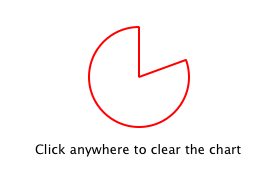Chapter 2: Connecting to C++ Methods and Signals
Files:
- declarative/tutorials/extending/chapter2-methods/app.qml
- declarative/tutorials/extending/chapter2-methods/piechart.cpp
- declarative/tutorials/extending/chapter2-methods/piechart.h
- declarative/tutorials/extending/chapter2-methods/main.cpp
- declarative/tutorials/extending/chapter2-methods/chapter2-methods.pro
Suppose we want PieChart to have a "clearChart()" method that erases the chart and then emits a "chartCleared" signal. Our app.qml would be able to call clearChart() and receive chartCleared() signals like this:
import Charts 1.0 import QtQuick 1.0 Item { width: 300; height: 200 PieChart { id: aPieChart anchors.centerIn: parent width: 100; height: 100 color: "red" onChartCleared: console.log("The chart has been cleared") } MouseArea { anchors.fill: parent onClicked: aPieChart.clearChart() } Text { anchors { bottom: parent.bottom; horizontalCenter: parent.horizontalCenter; bottomMargin: 20 } text: "Click anywhere to clear the chart" } }

To do this, we add a clearChart() method and a chartCleared() signal to our C++ class:
class PieChart : public QDeclarativeItem { ... public: ... Q_INVOKABLE void clearChart(); signals: void chartCleared(); ... };
The use of Q_INVOKABLE makes the clearChart() method available to the Qt Meta-Object system, and in turn, to QML. Note that it could have been declared as as a Qt slot instead of using Q_INVOKABLE, as slots are also callable from QML. Both of these approaches are valid.
The clearChart() method simply changes the color to Qt::transparent, repaints the chart, then emits the chartCleared() signal:
void PieChart::clearChart() { setColor(QColor(Qt::transparent)); update(); emit chartCleared(); }
Now when we run the application and click the window, the pie chart disappears, and the application outputs:
The chart has been cleared
Try out the example yourself with the updated code in Qt's examples/tutorials/extending/chapter2-methods directory.